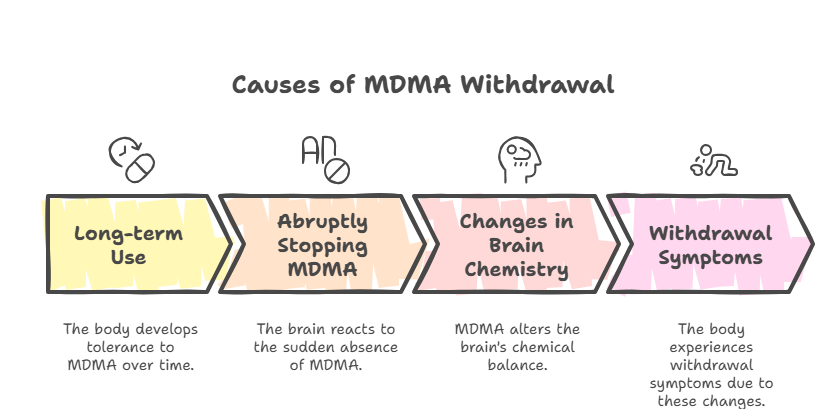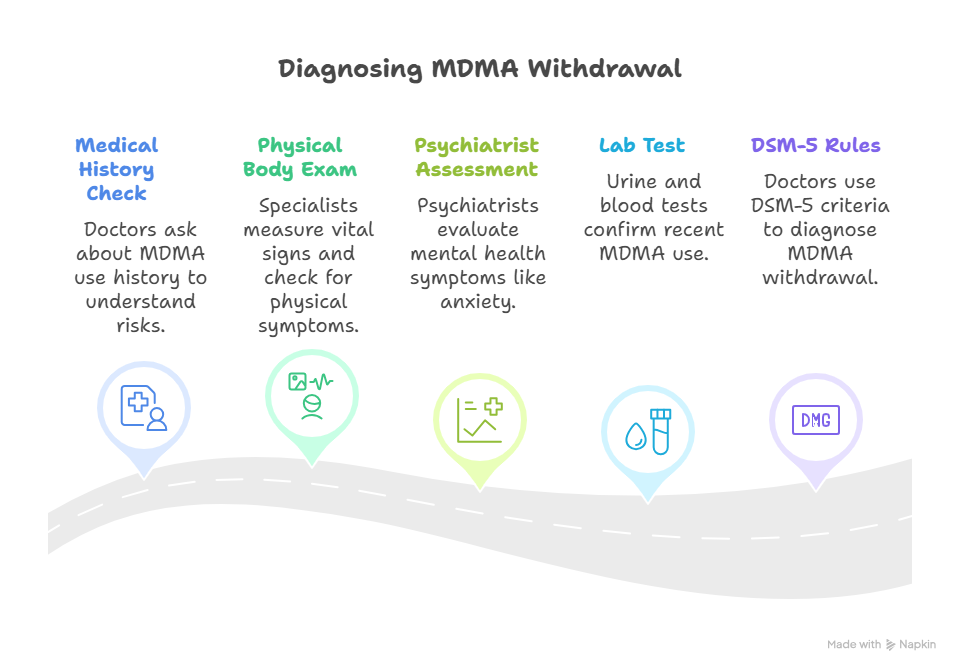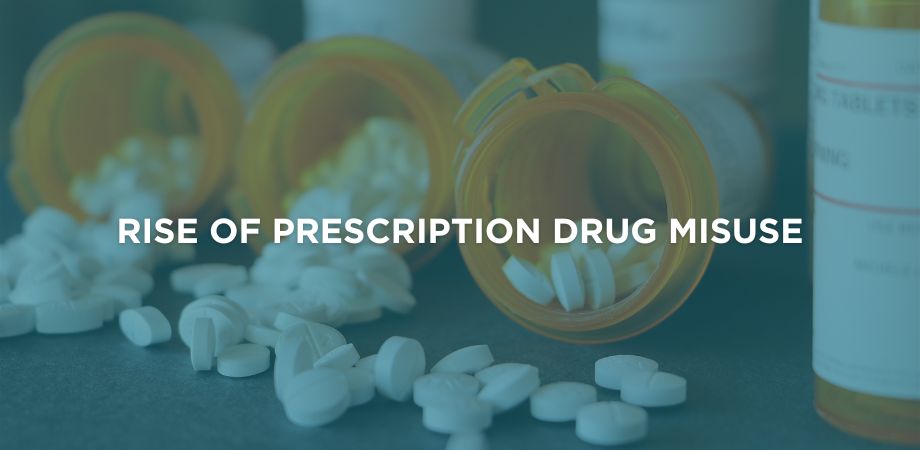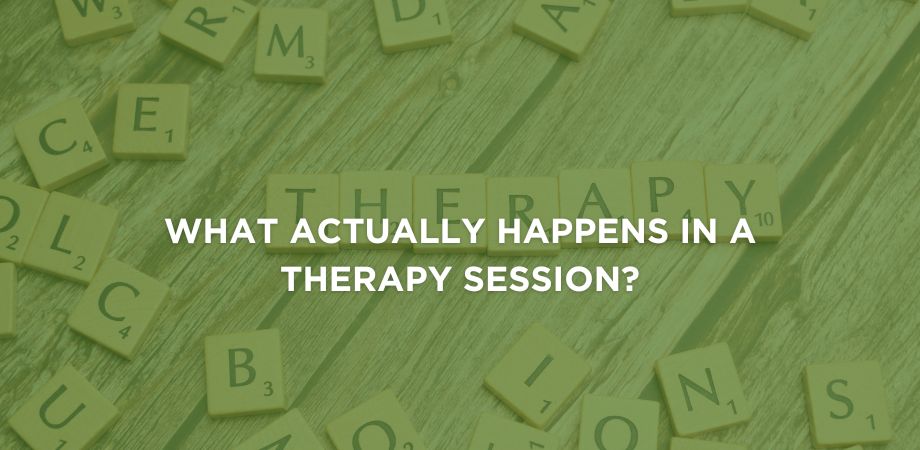MDMA withdrawal refers to a range of physical and psychological reactions that occur when someone with MDMA dependence or addiction abruptly stops or reduces its use. MDMA is short for 3,4-Methylenedioxymethamphetamine and is commonly known as Ecstasy or Molly.
The main causes of MDMA withdrawal are long-term use of MDMA leading to tolerance, abruptly stopping MDMA, and changes in brain chemistry. When someone stops using Molly, the central nervous system (CNS) has difficulty adjusting because brain neurotransmitters, such as serotonin, dopamine, and norepinephrine, become disrupted. This imbalance results from prolonged drug use that creates a substance use disorder (SUD).
The common symptoms of Ecstasy withdrawal include depression, high anxiety, suicidal thoughts, sleep disturbances, cravings, confusion, and impairment of memory and attention.
The timeline for MDMA withdrawal begins 2-6 hours after the last use, peaks at 1-3 days with symptoms like anxiety and irritability, gradually improves over 4-10 days, and mental health issues such as sadness and poor sleep may persist for a week or more.
The diagnosis of Ecstasy withdrawal involves MDMA detox, including medical checks, drug history use, and dual diagnosis screening for co-occurring disorders to see if other mental illnesses exist.
The common treatment methods for Molly withdrawal include medical detox, inpatient treatment programs, outpatient treatment programs, medications like antidepressants, plus support groups like Narcotics Anonymous (NA), counselling, and cognitive-behavioural therapy (CBT).
The main risk factors of untreated MDMA withdrawal include complications like kidney failure, haemorrhage, cardiovascular collapse, convulsions, and sometimes death.
Prevention strategies for MDMA withdrawal symptoms include gradually reducing Molly use, therapy, counselling, support groups, and selecting an MDMA addiction rehabilitation centre for detoxification.
What Is MDMA Withdrawal?
MDMA withdrawal refers to the body’s and brain’s reactions when someone stops or reduces MDMA use after prolonged use. Ecstasy withdrawal occurs when someone develops a substance use disorder (SUD) due to physical dependence, where the body requires MDMA to function normally, and psychological dependence, when the mind strongly craves Molly to manage feelings.
MDMA alters brain chemicals like serotonin (the brain’s mood chemical), dopamine (the ‘feel good’ chemical), and norepinephrine (the brain’s energy chemical). When MDMA wears off, the brain lacks enough of these chemicals, leading to mood swings and discomfort. Doctors call this MDMA withdrawal syndrome. In severe cases, known as acute withdrawal, symptoms are life-threatening and need medical supervision.
What is the Difference Between MDMA Withdrawal and MDMA Detox?
The main difference between MDMA withdrawal and MDMA detox is that MDMA withdrawal involves the body’s natural response when stopping MDMA use. In contrast, MDMA detox is the medical process of safely managing withdrawal symptoms like depression.
MDMA effects begin 2-6 hours after last Ecstasy use. The brain’s serotonin, dopamine, and norepinephrine levels drop after stopping Ecstasy use. Medical detox involves monitored care through recovery programs by addiction professionals who track vital signs, provide medications such as antidepressants, and ensure safety.
The table below compares MDMA withdrawal and MDMA detox key factors in medical care.
|
MDMA Withdrawal |
MDMA Detox |
|
It’s the body and brain reactions after one stops using MDMA after using it for an extended period of time. |
It’s a medical plan or process to help someone handle withdrawal symptoms, such as depression and cravings, safely. |
|
Starts 2-6 hours after the last Ecstasy dose. |
Safer with doctors, nurses, therapy, and family support. |
|
Symptoms include depression, fatigue, anxiety, trouble sleeping, memory problems and intense cravings. |
Doctors use medications such as antidepressants plus therapy to manage symptoms |
|
Symptoms peak 1-3 days and last for 1 week+ for symptoms like depression, cravings, and trouble sleeping |
Makes the severe withdrawal symptoms such as depression, anxiety, muscle tension and restlessness less painful and helps with recovery within the first week. |
|
Causes life-threatening symptoms such as convulsions, seizures, kidney failure, and haemorrhaging if it goes untreated. |
Stops risks such as seizures, kidney failure, haemorrhaging, and cardiovascular collapse by giving fluids, medications and emotional support. |
What are the Causes of MDMA Withdrawal?
The main causes of MDMA are:
- Long-term use leading to tolerance
- Abruptly stopping MDMA use
- Changes in brain chemistry
The main causes of Molly withdrawal are explained below.
- Long-term Use Leading to Tolerance: Tolerance means the body gets used to MDMA and needs more of the Ecstasy to feel the same high. At first, a small amount of Molly makes one feel good. After using it many times, the body and brain expect higher doses each time to get the same effect, leading to dependence on the drug to function normally.
- Abruptly Stopping MDMA Use: The brain has been depending on the drug to feel normal. When one stops taking Ecstasy all at once, one’s brain panics because it doesn’t know how to work without the drug. The sudden change causes Ecstasy withdrawal symptoms such as feeling sad, worried, and confused.
- Changes in Brain Chemistry: MDMA damages the part of the brain that makes serotonin, dopamine, and norepinephrine. The chemicals control one’s mood, sleep, and energy. Regular MDMA reduces serotonin levels by 20-60%. When Molly’s use stops, the brain cannot make the chemicals naturally, causing severe withdrawal symptoms like depression, anxiety, and sleep problems.

What Are the Symptoms of MDMA Withdrawal?
The main symptoms of MDMA withdrawal are impulsiveness, unusual feelings of affection, paranoia, confusion, sleep problems, lethargy, anxiety, depression, cravings, blurred vision, nausea, teeth clenching, muscle tension, dilated pupils, heightened sensory awareness, memory loss, faintness with Chills or swelling, euphoria, and impaired judgment. Severe Ecstasy withdrawal causes psychosis, brain damage, kidney failure, haemorrhaging, cardiovascular collapse, convulsions, and even death.
The MDMA withdrawal symptoms are categorised into physical and psychological symptoms.
Physical Symptoms of MDMA withdrawal
The physical MDMA withdrawal symptoms are:
- Thirst
- Teeth clenching
- Lethargy
- Muscle tension
- Dilated pupils
- Heightened sensory awareness
- Impaired judgement
- Confusion
- Sleep problems
- Faintness with Chills or Swelling
- Blurred vision
- Nausea
Severe physical symptoms of Ecstasy are:
- Kidney failure
- Hemorrhaging
- Cardiovascular collapse
- Convulsions
- Death
Psychological Symptoms of MDMA Withdrawal
Psychological MDMA withdrawal symptoms are:
- Impulsiveness
- Increased empathy
- False sense of attention
- Short-lived euphoria
- Paranoia
- Memory loss
- Promiscuity
- Severe anxiety
- Strong drug cravings
- Depression
Severe psychological Ecstasy withdrawal symptoms are:
- Brain damage affecting learning, sleeping, and emotions
The physical and psychological Molly withdrawal symptoms are further divided into mild, moderate, and severe.
Mild MDMA Withdrawal Symptoms
The mild MDMA withdrawal symptoms start within 24 hours after the last Ecstasy dose.
The mild Molly withdrawal symptoms are:
- Thirst
- Teeth clenching
- Lethargy
- Trouble sleeping
- Anxiety
- Impulsiveness
- Mood swings
- False affection
The mild Ecstasy withdrawal symptoms are explained below.
- Thirst is feeling dry in the mouth, and you need to drink water all the time.
- Teeth clenching occurs when the jaw becomes tight and one unintentionally grinds their teeth.
- Lethargy is a state where the body feels heavy and weak, as if one doesn’t have enough energy.
- Trouble sleeping is having difficulty falling asleep or staying asleep at night.
- Anxiety is feeling nervous or worried for no apparent reason.
- Impulsiveness is acting or walking without thinking first.
- Mood swings are feelings that change quickly, like from happy to sad.
- False affection is acting or faking being very loving or close to people, but it’s only because of the Ecstasy effect.
Moderate MDMA Withdrawal Symptoms
The moderate symptoms of MDMA withdrawal are:
- Paranoia
- Memory loss
- Muscle tension
- Dilated pupils
- Blurred vision
- Nausea
- Confusion
- Cravings
- Restlessness
- Heightened sensory awareness
The moderate MDMA withdrawal symptoms are explained below.
- Paranoia is the tendency to think that people are against you or watching you, even when they’re not.
- Memory loss is the inability to recall simple things, such as names or recent events.
- Muscle tension occurs when muscles feel stiff or sore and refuse to relax.
- Dilated pupils are eyes that look bigger than usual, even in bright light.
- Blurred vision occurs when objects appear fuzzy and you struggle to see them clearly.
- Nausea is a sensation in the stomach that makes you feel like you might vomit.
- Confusion is failing to think clearly or make good choices.
- Cravings are the strong urges to use MDMA again, even when it’s bad for your health.
- Restlessness is characterised by an inability to sit still and a tendency to move around constantly.
- Heightened sensory awareness is when lights look too bright and sounds feel too loud.
Severe MDMA Withdrawal Symptoms
The Molly severe withdrawal symptoms are:
- Severe depression
- Severe anxiety
- Psychosis
- Brian damage
- Degenerated nerve branches
- Hemorrhaging
- Cardiovascular collapse
- Kidney failure
- Convulsions
- Death
The severe withdrawal symptoms of MDMA are explained below.
- Severe depression is feeling sad, empty, and hopeless for a long time.
- Severe anxiety is feeling intense fear or panic that doesn’t stop.
- Psychosis is seeing or hearing things that aren’t real.
- Brain damage occurs when the brain is damaged by MDMA use, making it hard to think or feel normal.
- Degenerated nerve branches are the brain’s wiring breaking down, so signals don’t pass well.
- Haemorrhaging is bleeding inside your body, which is life-threatening.
- Cardiovascular collapse occurs when the heart stops functioning as it should.
- Kidney failure occurs when the kidneys are unable to effectively filter the blood and remove waste products in the urine.
- Convulsions are uncontrollable, hard body shakes.
- Death is the worst case of Ecstasy withdrawal, in which your body shuts down completely.
What Are the Early Signs of MDMA Withdrawal?
The early signs of MDMA withdrawal are:
- Feeling very tired and weak
- Trouble sleeping or waking up often
- Feeling sad or empty (depression)
- Worrying too much (anxiety)
- Not wanting to eat
- Headaches
- Being restless and unable to stay still
- Strong urge to use MDMA again
- Mood swings, like happy one moment and angry the next
- Trouble focusing or remembering things
How Long Does MDMA Withdrawal Last?
MDMA lasts for 2-4 weeks, with acute symptoms easing within 7 to 10 days, and psychological issues such as depression last longer.
MDMA withdrawal timeline starts 3-6 hours after last use and symptoms such as cravings, depression, and confusion peak in the first 1-3 days, and then slowly improve after 4-10 days; however, symptoms like depression and poor sleep last for a week+. A case study by PubMed reported that some heavy MDMA users show memory and mood issues even after years of quitting.
Here’s a timeline of MDMA withdrawal showing how Ecstasy symptoms progress over time.
- Early Withdrawal Stage: It starts 3-6 hours after the last Molly dose, with signs such as irritability, thirst, anxiety, and poor sleep.
- Peak Withdrawal Stage: It’s the most intense stage, starting 24-72 hours (1-3 days) after the last Ecstasy dose, with symptoms such as depression, paranoia, confusion, memory loss, and intense cravings.
- Late Withdrawal Stage: It begins 4-10 days after, when symptoms such as fatigue, nausea, blurred vision, and muscle tension start to ease.
- Past-Acute Withdrawal Stage (PAWS): It starts 2 to 4 weeks after cessation, with symptoms such as lingering depression, poor sleep, occasional cravings, and low motivation that continue. A study shows Ecstasy heavy users continue to experience memory problems and anxiety even after long-term Molly abstinence.
The table below shows a complete MDMA withdrawal timeline and symptoms at each stage.
Stage | Timeline | Primary Symptoms |
Early Withdrawal | Starts 2-6 hours after last Ecstasy dose | Fatigue, irritability, thirst, anxiety, sleep problems |
Peak Withdrawal | Starts 24-72 hours (1-3 days) after last Molly dose | Depression, paranoia, confusion, memory loss, intense cravings |
Late Withdrawal | Starts 4-10 days after last MDMA dose | Symptoms such as fatigue, nausea, blurred vision, mood swings, and low motivation start to improve |
Post-Acute Withdrawal Stage (PAWS) | Spans 2-4 weeks, with some symptoms such as occasional cravings may persist for over a month | Lingering depression, poor sleep, lack of motivation, and occasional cravings |
How Do Doctors Diagnose MDMA Withdrawal?
Doctors diagnose MDMA withdrawal by reviewing drug history, conducting a physical exam, and using mental health assessments. According to MIMHANS, doctors must exercise caution when diagnosing MDMA to make sure symptoms are caused by MDMA and not by another illness. MDMA misdiagnosis delays proper care and risks severe symptoms such as convulsions and cardiovascular collapse.
Here are the tools and steps doctors use to identify and diagnose MDMA withdrawal.
- Medical history check
- Physical body exam
- Psychiatrist assessment
- Lab test
- DSM-5 rules
The doctor’s steps and tools for diagnosing MDMA withdrawal are explained below.
- Medical History Check: Medical history checks are doctors asking when one last took MDMA, how often, and what amounts. This helps link symptoms to drug use and understand possible risks from withdrawal.
- Physical Body Exam: The physical body exam is for addiction specialists, measuring heart rate, blood pressure, sleep patterns, and overall body energy. They’ll check for headaches, muscle tension, and restlessness to see how the withdrawal is affecting the body.
- Psychiatrist Assessment: A psychiatric assessment involves a doctor’s evaluation for sadness, anxiety, paranoia, and memory loss because MDMA affects mental health. This helps distinguish Ecstasy withdrawal from other mental illnesses like depression or panic disorder.
- Lab Test: Lab tests are urine and blood tests to confirm recent MDMA use. They don’t prove withdrawal alone but support diagnosis with history and symptoms.
- DSM-5 Rules: DSM-5 is the official medical guide that helps identify and diagnose MDMA withdrawal.

What Are the Treatment Options for MDMA Withdrawal?
The common treatment options for MDMA withdrawal include medical detox, medications, inpatient treatment programs, outpatient treatment programs, counselling, cognitive behavioural therapy, and support groups.
The treatment options for MDMA withdrawal are explained below.
Medical Supervision
Medical supervision involves doctors closely monitoring the patient, checking heart rate, blood pressure, and sleep, as well as administering medications to ensure withdrawal doesn’t become dangerous.
Medical Detox
Medical detox is MDMA detox performed at a hospital or rehabilitation centre by trained addiction specialists who provide full-time care until the body stabilises and symptoms are managed.
Medications
Medications are drugs prescribed by doctors to help lessen Molly withdrawal symptoms. Currently, there are no FDA-approved medications, but doctors use antidepressants like Prozac to help reduce sadness, anxiety, and insomnia.
Outpatient Treatment Program
An outpatient treatment program means living at home while visiting an addiction treatment facility for medical check-ups and therapy.
Inpatient Treatment Program
An inpatient treatment program means staying full-time in a rehab centre for daily counselling, medical care, and therapy.
MDMA Therapy
MDMA therapy includes cognitive behavioural therapy (CBT), where one talks to a psychologist knowledgeable about MDMA withdrawal to help manage cravings and triggers, and teach healthy coping skills.
Support Groups
Support groups are meetings like Narcotics Anonymous (NA) where people share their drug use struggles, encourage each other, and help prevent MDMA relapse.
What Are the Risks of Untreated MDMA Withdrawal?
The common risks of untreated MDMA withdrawal are listed below.
- Cognitive impairments involve trouble with memory, focus, and learning because MDMA lowers brain chemicals like serotonin (the brain’s mood chemical) and norepinephrine (the brain’s energy chemical), making it harder for the brain to think or remember.
- Neurological damage is the harm to the brain and nerves. Molly burns out brain nerve endings, so signals in the brain don’t travel properly.
- Cardiovascular problems refer to heart and blood-related issues, such as heart failure. Ecstasy makes the heart beat fast and raises blood pressure, which, over time, leads to heart failure and collapse.
- Severe mental health disorders are problems like anxiety, depression, and memory loss. MDMA drains dopamine (the brain’s happy chemical), which makes the disorders grow worse without help.
- Brain damage to key areas refers to harm to parts of the brain that control learning, sleep, and emotion. MDMA scrambles the brain’s ‘switchboard’, so signals are sent the wrong way.
- Degenerated nerve endings occur when the brain’s nerves shrink and die because Ecstasy overworks them, so mood, thinking, and reaction speed slow down.
- Kidney failure occurs when the kidneys stop functioning properly to remove waste from the body because MDMA causes overheating and dehydration.
- Haemorrhaging is bleeding inside the body or brain. Molly raises blood pressure and weakens blood vessels, causing them to burst.
- Psychosis is when someone sees or hears things that are not real because MDMA changes chemicals, causing confusion and paranoia.
- Convulsions are strong body shakes or seizures. MDMA withdrawal overstimulates the nervous system, leading to loss of control.
- Death is when the brain, heart, and kidneys shut down fully; the body cannot survive. Untreated Ecstasy withdrawal leads to this final risk.
How to Prevent MDMA Withdrawal
To prevent MDMA withdrawal, consider the following safe steps.
- Gradual Tapering: Gradual tapering is lowering the amount of MDMA one uses slowly instead of stopping at once. This allows the body and brain to adjust safely and effectively.
- Medical Supervision: Medical supervision involves collaborating with doctors during detox treatment programs to monitor for risks, administer medications as needed, and make the withdrawal process safer and more effective.
- Family Support: Family support involves family and trusted friends who help with motivation, emotional care, and reduce the chance of relapse. Other support groups include Narcotics Anonymous (NA) and therapy sessions in MDMA addiction rehab centres.
- Relapse Prevention: Relapse prevention involves learning coping skills through therapies such as cognitive-behavioural therapy (CBT) or dialectical behaviour therapy (DBT). They teach how to handle cravings, stress, and triggers that cause a return to Molly use.
What's the Difference Between Ecstasy ‘Comedown’ and Ecstasy Withdrawal?
The main difference between Ecstasy comedown and ecstasy withdrawal is the timing and cause. An Ecstasy comedown or “crash” is temporary and occurs hours after use when the drug wears off. It’s like a hangover after drinking alcohol. Ecstasy comedown is associated with a single session, leading to short-term fatigue, low mood, and irritability.
Ecstasy withdrawal occurs after frequent or intense MDMA use when the brain adjusts to the drug and then struggles to function without it. This leads to prolonged issues such as anxiety, sleep disturbances, and depression that last days or weeks. Molly withdrawal tends to be more intense, lasts longer, and is connected to MDMA dependence.
What is the Difference Between MDMA Dependence and MDMA Addiction?
The main difference between MDMA dependence and MDMA addiction is that MDMA dependence means your body and brain get used to the drug. When you stop using Molly, you experience withdrawal symptoms such as fatigue, irritability, poor sleep, anxiety, and depression. MDMA addiction goes further. It means, besides MDMA dependence, you also lose control over its use, crave Ecstasy, and use it even when it causes harm to your health, school, work, or relationships.
Signs and symptoms of MDMA dependence syndrome include:
- Needing more Ecstasy to feel the same effect (tolerance).
- Feeling tired, sad, and anxious when you don’t use Molly.
- Trouble sleeping without the drug
- Using MDMA regularly despite the harm it causes to your health, relationships, work, or school.
- Craving Ecstasy so much that you lose control of the urge.
- Spending a lot of your time thinking about getting the drug.
- Losing interest in hobbies and activities you found fun.
What is the difference between MDMA Withdrawal and MDMA Overdose?
The main difference between MDMA withdrawal and MDMA overdose is that withdrawal happens after you stop using MDMA, when your brain is adjusting to not having the drug, leading to sadness, anxiety, poor sleep, and fatigue. MDMA overdose or poisoning happens when you take too much MDMA at once, and the body can’t handle it. This causes dangerous effects like high body temperature, fast heartbeat, high blood pressure, confusion, and organ failure, such as the kidneys or heart.
MDMA withdrawal makes you feel unwell for weeks, but MDMA overdose/poisoning is a medical emergency that causes seizures, kidney failure, or death within hours if untreated.





